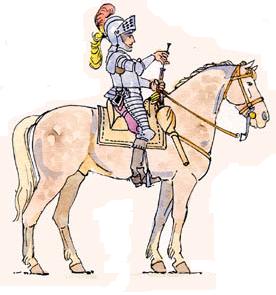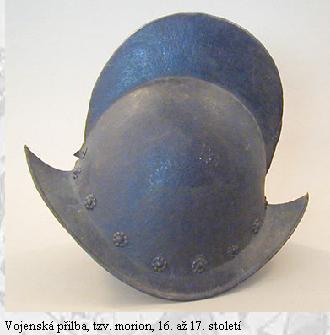Tak tento pěknej článek musím dát přečíst svému devítiletýmu synovi, protože o staré zbraně má velký zájem a měděný reliéf pravděpodobně zcizili naši opálenější spoluobčané, kterým není nic svaté! 
The Thirty Years' War - Armaments
Categories: Years of war and revolution , Třicetiletá válka
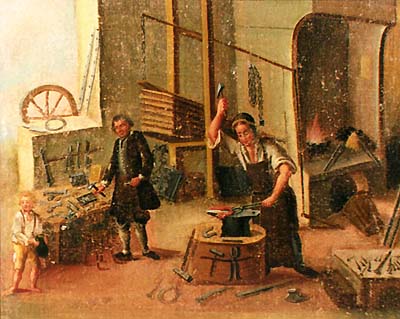
In the period before the Thirty Years' War, the arms industry was mainly run by craftsmen. Some craftsmen were renowned for their work and their reputation was known for generations. However, after the outbreak of the war, much changed and more armaments were needed. The main requirement was quick, cheap and simple production. There was no time or money for the art of craftsmanship. The great era of the manufactories had begun. The army was happy with the cheap and quick production of the manufactories, so the army awarded all the contracts to them. Because of this, the guild system of crafts began to break down and the time of mass production arrived.
The army commanders started to run their own business, which earned them a good amount of money. This allowed them to move among the high aristocracy. They built luxurious mansions, and if they didn't have a contract, they would retreat from the courts to their estates.
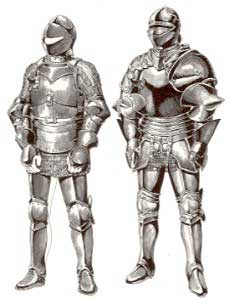
The main equipment of the soldiers was the pay armour (worn mainly by mounted soldiers), which couldcould protect the soldiers from enemy fire, because the effectiveness of muskets and arquebuses at a distance was not very high.
Musket is a long handgun with a breech-lock (and later a wheel-lock), front-loading (16th-17th centuries). The smoothbore barrel of 17-25 mm has a range of 200-300 m. The weight of the weapon was 8-10 kg, so it is supported by a supporting fork (furket) when firing. The name was transferred to later weapons and was used until the 19th century.
Arkebuza is a hand-held firearm with a breech-lock, later a wheel-lock. At the time of its creation, in the 14th-15th centuries, it was actually a "hook cannon". It had a medium calibre and was shorter and lighter than a musket. It was used until about the middle of the 17th century.
Cigar lock, muskets and arquebuses
The DOUTNACK LOCK appears in the second half of the fifteenth century and is probably the first trigger mechanism to ignite powder in a breech block. Three basic types of lock gradually evolved, used from the fifteenth to the seventeenth century. The first of these is the serpent, where the mechanism consists of an S-shaped arm that rotates about its centre along the side of the stock at the rear of the barrel. A piece of rope impregnated with a combustible substance is attached to the top of the arm and lit on one end (the quiver). The lower part of the arm serves as a trigger. When squeezed, the lighted fuse is bent and ignites a small amount of powder sprinkledon a horizontal pan located at the rear of the barrel near the hole in the wall of the chamber. When the powder on the pan ignites, the flame blows through the stopper and ignites the powder charge in the barrel. The second type is the spring-loaded breech-lock, in which the breech-lock is held in the standby position under theThe spring is held in a steady state by the pressure of the spring and, by depressing a lever on the lower part of the stock, it is released and tilted towards the pan. The whole device is mounted on an elongated plate set into the stock from the side and referred to as the lock plate. Inside, the slide is connected to an embedded lever which is acted upon by a spring. The final refinement of the cigar lock was the introduction of the trigger, which appeared in the last quarter of the fifteenth century. It is now in its modern form with a bow and acts vertically on a rectangular trigger lever which, by a rotary movement under the influence of a spring, inclines the slide towards the pan. The development of the breech-lock enabled the soldier or hunter to follow the target while firing instead of the pan, as was the case when the breech-lock was manually cocked. However, it also had its drawbacks. The cigarlock had to burn constantly, which was dangerous in the vicinity of dust, and it was difficult to use in wet or windy weather.

Dustbowl
Musketeers wore them from about 1608, and for safety reasons they were made of non-ferrous materials such as cow horn. The muskets were supported by forked supports - furkets.
Knights also wore plate armour. It protected them from head to knees, so the arms were also protected. On their hands they wore articulated metal gloves. The thighs were covered with slats. The chest plate was designed to protect the soldier from the fire of a more powerful musket. The footwear was leather and high (riding boots), with spurs on the sides, and the cuirassiers carried a sword at their hip, usually a palash adapted for both slashing and point. According to their equipment, cuirassiers were divided into two groups:
-
S two wheeled pistols carried in holsters mounted
on the front sides of the saddle
-
The second group still had a heavy type of cavalry lance, although this weapon had already slowly begun to disappear from the armament of the heavy cavalry by the early 17th century. Long lances of the lighter type survived only in the irregular cavalry units of some Eastern European nations.
Arquebusiers or carabineers, wore only a breastplate and a type-morion helmet. Armament included a short wheeled rifle, an arquebuse, and one or two pistols. They also carried a sidearm. The arquebuse was suspended by a hook from a so-called bandolier, and the pistols were also holstered.
The cuirassiers and arquebusiers usually fought on horseback, and mainly with firearms.
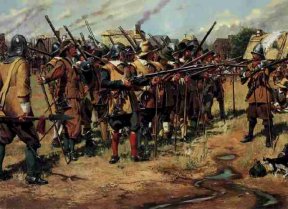
Dragoons were part of a different type of army. They used horses only to move to the battlefield. They moved like cavalry but fought like infantry. The name derives from the weapon they most often used, a carbine or short musket (drago). The meaning comes from the expression "to spit fire", the flash of fire and smoke after a shot. This method of deployment disappeared during the 18th century (with the exception of the dragoon regiments of the Russian army, which were trained for this method of deployment during the Seven Years' War), and gradually the dragoons evolved into a type of regular cavalry standing between light (which was mainly used for reconnaissance) and heavy (carrying out attacks in battles). Its training was not fundamentally different from that of regular infantry. Also, their organization was very similar to the regimental structure of the infantry. The dragoon did not need as good horses as other soldiers who moved exclusively on horseback. In an emergency, therefore, he could abandon the horse and it did not mean a great financial loss. Dragoon horses were often abandoned on the battlefield because when a dragoon dismounted to fight on foot, he would pull the reins of his horse over the neck of his neighbor's horse. This created a long line of connected horses, which were usually left under the care of a few veterans. If the battle was lost, the dragoon might have considerable difficulty in hastily finding his horse somewhere in the middle of the line.

Regiment was the organizing unit of the cavalry. The regiments of the Imperial Army had 500 to 1,000 cavalrymen. However, during the Thirty Years' War, they were barely at full strength; a unit of 700 men was already considered strong. The commander was the colonel or whoever recruited the regiment. The regiment was divided into companies and each had its own standard - the guidon (a triangular flag attached to the forage, carried by the company cornet).
The most common battle formation in the 17th century was the so-called. CARACOLAhad two ways of fighting:
- The first line of cavalry attacked frontally, approached the enemy at about 30 -50 paces and then fired. Then they turned their horses around and leveled off. They then moved back to make room for the next line to reload their weapons.
- The attack was in single file. If the enemy was on the right, the soldiers fired, formed a large circle, and the whole line then returned to its original position in formation. During this manoeuvre, a charge was made.
The essential thing to success was a good choice of horse and its training. The horse had to stand still even when firing was going on and had to obey his master at a word. A good saddle was also important, so that the rider had a firm seat but at the same time did not injure the horse. The stables had to be clean so that the horse did not get sick. In the 17th century, however, cavalry lost its priority and the army was dominated by infantry.
Finds of arms and armaments in the Czech Republic
Mileč
At the crossroads in the direction of Třebčice there is a God's Torment, consisting of a brick plinth and a cylindrical shaft with an entasis. It marks the place where weapons and helmets from the Thirty Years' War were found. According to tradition, it was the site of the clash between the Swedish and Imperial armies.
The Pile of the Dead (Krušné hory and Podkrušnohoří - centre)
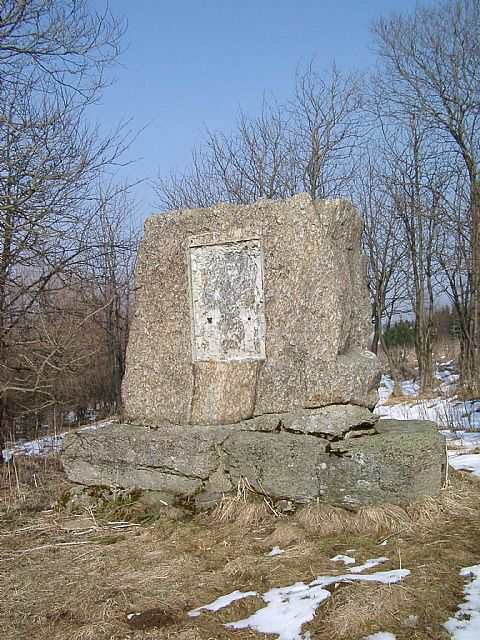
The Palouk of the Dead is a peat bog located near the Kovářská railway station. The place is also called "the peat bog of death", because a whole detachment of heavy Swedish cavalry drowned here in 1641 during the Thirty Years' War. Previously, this event was considered more of a legend, but in 1924, weapons and the remains of soldiers and horses were actually found here during peat extraction.
There was a copper relief on a granite base at the site of the tragedy, but unfortunately today only the stone base remains, as the copper plaque on the front has been stolen.
The article is included in categories:
- Archive of articles > Years of war and revolution
- Archive of articles > Years of war and revolution > Třicetiletá válka
Post
Velmi hezky,zajimavi a poutavi clanek...
Pěkný článek, ale máte tam pár podstatných nesrovnalostí
Je to fakt dobrý!!!!!!!!!!!!
Je tam úplně všechno
Pro získání informací o 3O.-leté válce mohu doporučit publikace pojednávající o Albrechtu z Valdštejna,jedné z hlavních postav tohoto období.Těch publikací u nás vyšla celá řada,často popisují detailně veškeré okolnosti,včetně těch,jež se týkají výzbroje a vybavení.Jen bych doplnil pasáž o použití dlouhého kopí jízdou- kopí,respektive píka byla ve výzbroji jízdy jěště ve 2 sv.válce,např.polské hulánské oddíly.Dále v tomto hezky zpracovaném článku mi trochu chybí v pasáži týkající se pěchoty vedle mušketýrů pikenýři,nezbytná to součást pěších formací jako obrana proti kavalerii.Jako příklad lze uvést španělskou tercii,jež svým věhlasem inspirovala armády ostatních zemí.
Pro získání informací o 3O.-leté válce mohu doporučit publikace pojednávající o Albrechtu z Valdštejna,jedné z hlavních postav tohoto období.Těch publikací u nás vyšla celá řada,často popisují detailně veškeré okolnosti,včetně těch,jež se týkají výzbroje a vybavení.Jen bych doplnil pasáž o použití dlouhého kopí jízdou- kopí,respektive píka byla ve výzbroji jízdy jěště ve 2 sv.válce,např.polské hulánské oddíly.Dále v tomto hezky zpracovaném článku mi trochu chybí v pasáži týkající se pěchoty vedle mušketýrů pikenýři,nezbytná to součást pěších formací jako obrana proti kavalerii.Jako příklad lze uvést španělskou tercii,jež svým věhlasem inspirovala armády ostatních zemí.


